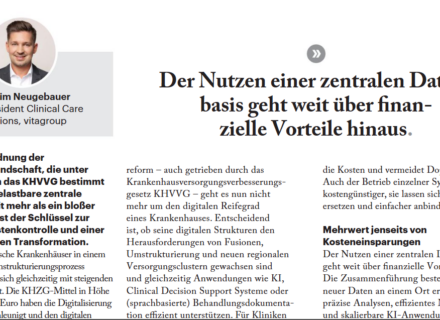Open platforms: the backbone of healthcare innovation
Healthcare innovation needs collaboration — and open platforms like vitagroup’s HIP (Health Intelligence Platform) make it possible. By separating data from applications, HIP enables different vendors to build and connect apps seamlessly to a shared electronic health record, speeding up innovation that ultimately provides more efficient healthcare and better patient outcomes.

Traditional monolithic healthcare systems, while comprehensive, have become obstacles to progress. Their rigid architecture, complexity, and limited interoperability create vendor lock-ins, with healthcare organisations relying on sole vendors to provide any changes or innovations to meet their evolving needs. This dependency makes integrating third-party solutions into their system difficult, costly and time-consuming. And hence, they almost never happen.
In contrast, open platforms, by default, support collaboration and are seen as a key tool for accelerating innovation in healthcare. By separating data from applications, open platforms are technology agnostic and enable healthcare organisations to rapidly adopt, upgrade, or replace solutions from any vendor. This inherent flexibility eliminates the constraints of legacy monolithic systems, empowering organisations to build a dynamic ecosystem of applications that best suit their needs.
How does it actually work?
To develop a single clinical application that would run inside the healthcare system, there are lots of things developers need to consider:
- They must create custom data mappings and integrations for every system, requiring significant effort and maintenance.
- They need to build security, authentication, and data models from scratch.
- Scalability is difficult, requiring manual reconfiguration and infrastructure upgrades.
- They must manually implement and maintain compliance measures, increasing costs and risks.
- Proprietary software licenses and infrastructure investments also significantly increase development costs.
Developing applications on top of an open platform removes all the above requirements and provides developers with a ready-made foundation of standardised data models, security frameworks, interoperability protocols, and scalable infrastructure, allowing them to focus on innovation rather than backend complexities. Key features of the open platform include:
- Unified data layer: Open platforms store structured data in central repository, enabling developers to build applications that leverage this data.
- Predefined data models: Vendors can use predefined data models (openEHR Archetypes and Templates), and FHIR resources to reduce development and implementation time. This modular approach allows developers to focus on application logic instead of data modelling.
- Industry standards: Open platforms adopt widely accepted standards such as HL7, FHIR and openEHR, ensuring seamless data exchange across different healthcare systems.
- Standardised APIs: Incorporating standardised APIs ensures plug-and-play integration with existing healthcare infrastructure, without having to build custom integrations for each internal system.
- Pre-built modules: Authentication, patient data management, and cloud deployment are already included, simplifying development and accelerating time-to-market.
- Cloud scalability: Built-in support for microservices and scalable cloud infrastructure enables seamless growth and expansion as app usage increases.
- Regulatory compliance: Pre-integrated compliance frameworks ensure data protection and regulatory adherence from the start.
- Free access: open platforms are free to access, all APIs and datapoints can be made available to eligible third parties without restrictions from the platform vendor.
A case in point: vitagroup’s EHRbase and HIP
vitagroup’s EHRbase and HIP platforms form a powerful foundation for healthcare innovation. EHRbase is the leading open-source platform underpinned by openEHR standard, offering the basic Clinical Data Repository (CDR) functionalities for storing and acccessing clinical data. It’s ideal for getting started quickly: it’s easy to explore, developer-friendly, and already used by over hundreds of organisations and individuals.
HIP is designed for enterprise-scale deployments, providing the robust, compliant infrastructure required to implement open data platforms across hospitals, regions, and national systems. It supports structured data governance, security, and long-term scalability. “It‘s important that we provide an independent and open platform that doesn’t favour any vendor,” say Matt Cox, vitagroup’s Chief Customer Officer. “This encourages app ecosystems to develop.”
It‘s important that we provide an independent and open platform that doesn’t favour any vendor.
Matt Cox
Chief Customer Officer, vitagroup

EHRbase helps vendors to easily adapt openEHR. This low-barrier approach is proving successful – by offering EHRbase as a freely accessible resource, vitagroup has seen organic growth in adoption, with multiple companies independently building clinical applications on top of the platform. Some of those include:
- Big Picture Medical addresses workflow and care coordination.
- Healthbrain (from Switzerland) specialises in care coordination, cross-organizational and cross-sector processes.
- Medblocks provides modular tools for building applications underpinned by openEHR platforms.
- openOutcomes (commissioned by the Apperta Foundation) focuses on patient-reported outcomes.
All, amongst many others, have developed applications on top of the EHRbase platform completely independently from vitagroup. “They just went to GitHub, downloaded the source code, and started working on developing their applications,” says Dr. Birger Haarbrandt, Head of Technology Advisory & Consulting at vitagroup. To make the journey towards open platforms and standards even more pleasant and easy, vitagroup has set up a sandbox environment which allows users to quickly explore its core capabilities. “With the EHRbase sandbox, developers can get a very quick grasp on the core concepts of openEHR. With its improved developer experience, it also provides a productivity boost for more experienced users”.
At vitagroup we wanted to test how quickly they could transition to an enterprise level solution. We worked to integrate all of them and connecting them to vitagroup’s HIP platform was straightforward, with integration taking just between five and ten business days. “By building all applications on EHRbase, we leverage a common openEHR REST API, achieving the highest level of interoperability”, explains Dr. Haarbrandt. “Instead of translating data between systems, all applications work with a single, consistent data source, creating a truly unified healthcare platform.”
All applications work with a single, consistent data source, creating a truly unified healthcare platform.
Dr. Birger Haarbrandt
Product Manager, vitagroup

Future strategy
At vitagroup we want to build on this and nurture an ecosystem of applications built on our platform by different vendors. “Our goal is to establish EHRbase as the technical and economical obvious choice for new application vendors, supporting innovation through a well-defined development environment and structured platform governance, making it easier for new solutions to integrate and thrive,” says Dr. Haarbrandt.
This, of course, requires a strong technical foundation. By ensuring high standards for data processing, governance, and performance, we provide a reliable foundation for seamless application integration, adds Dr. Haarbrandt. “Additionally, we contribute to the establishment of industry-wide data communication and storage standards, allowing customers to benefit from cost-efficient, competitive solutions where applications focus on value delivery without the complexity of managing data processing individually.”



